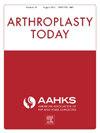Massive Periacetabular Osteolysis Treated With Acetabular Cup Retention and Cemented Screw Fixation
IF 1.5
Q3 ORTHOPEDICS
引用次数: 0
Abstract
Management of periacetabular osteolysis is a challenging dilemma in revision total hip arthroplasty. When the acetabular shell is well-fixed, the surgeon may prefer to retain the cup to minimize further bone loss. However, filling the surrounding defect can be difficult if the area of involvement is massive. In this case, holes were created in the existing acetabular cup for supplemental pelvic screws, which were placed using computed tomography navigation, and then the areas of osteolysis were filled with cement. The patient recovered uneventfully, and he was satisfied with the outcome at 4 years postoperatively. Thus, pelvic screw placement with cement augmentation could be a viable option for a stable cup with surrounding osteolysis. Patient selection should be considered carefully as the long-term outcomes of this procedure are unknown.
求助全文
约1分钟内获得全文
求助全文
来源期刊

Arthroplasty Today
Medicine-Surgery
CiteScore
2.90
自引率
0.00%
发文量
258
审稿时长
40 weeks
期刊介绍:
Arthroplasty Today is a companion journal to the Journal of Arthroplasty. The journal Arthroplasty Today brings together the clinical and scientific foundations for joint replacement of the hip and knee in an open-access, online format. Arthroplasty Today solicits manuscripts of the highest quality from all areas of scientific endeavor that relate to joint replacement or the treatment of its complications, including those dealing with patient outcomes, economic and policy issues, prosthetic design, biomechanics, biomaterials, and biologic response to arthroplasty. The journal focuses on case reports. It is the purpose of Arthroplasty Today to present material to practicing orthopaedic surgeons that will keep them abreast of developments in the field, prove useful in the care of patients, and aid in understanding the scientific foundation of this subspecialty area of joint replacement. The international members of the Editorial Board provide a worldwide perspective for the journal''s area of interest. Their participation ensures that each issue of Arthroplasty Today provides the reader with timely, peer-reviewed articles of the highest quality.
 求助内容:
求助内容: 应助结果提醒方式:
应助结果提醒方式:


